I’m going to say it – I love vaccinations. I was among the first generation of my maternal bloodline that did not have someone contract tuberculosis. The addition of the BCG vaccination to the British vaccination schedule in 1950, and the herd immunity it resulted in, is most likely the reason my peers and I were spared.
My grandmother, ‘Mam’ to me, suffered polio as a child. I grew up hearing stories of how her childhood was spent in calliper-style leg braces, her life a whirlwind of school, loving family and physiotherapy. She was one of the lucky ones.
In the epidemic of 1949, 2,720 people died from polio in the US. I grew up hearing stories of how families queued for hours, around the block, in 1956 when Jonas Salk’s vaccine arrived in the UK. I grew up hearing exactly why vaccination is one of the most significant advances in medical history – it’s right up there with antiseptics and antibiotics.
Forward to today, and Pfizer and BioNTech announced in early November that their COVID-19 vaccine is 90 percent effective at preventing the infection.
For those who are extremely clinically vulnerable, like myself, it feels like a tiny light at the end of the tunnel has finally been glimpsed.
However, within moments, my initial relief was swept aside by concern. We now live in an age of ‘Dr Google’, YouTube and Facebook ‘experts’ and rife medical misinformation – especially when it comes to COVID-19 and vaccinations.
How many people will turn down the COVID-19 vaccination? How many people will be taken in by the outright lies that vaccines contain pure mercury (as my colleague Claire pointed out – see PN 2626–2627 – the preservative thimerosal is not mercury) or cells from aborted embryos? How many people will believe the falsehood that vaccines cause autism? How many people will continue to be a possible transmission vector for this devastating virus?
Now, all but extreme anti-vaxxers at least agree that polio is horrific. There is a reason that the World Health Organisation, the Gates Foundation and others have spent the last 20 years trying to eradicate it. The statistics show that, in up to 70 percent of cases, polio patients are asymptomatic, able to spread the virus but suffering none of the debilitating effects.
Only 0.1–0.5 percent of patients experience paralytic polio; the kind that conjures images of children in iron lungs and leg braces like my Mam. Compared to the case fatality rate of COVID-19, which varies wildly from 0.25-10 percent, depending on location, age of population, available medical facilities and so many other factors, we suddenly see exactly how serious the current pandemic is.
The biggest and most common lie I hear about vaccinations is that they cause autism.
As the mother of a fantastic, curious, autistic child, I find this excuse to forego vaccination genuinely offensive.
The worst thing a child can be is dead, not autistic.
Yet this untruth, based on the deeply-flawed study of the now struck-off Andrew Wakefield has led to a decrease in vaccination uptake, particularly in the Western world.
It’s an empirically-proven scientific fact: vaccines prevent 2–3 million deaths per year from things like measles, whooping cough and yes, polio.
If COVID-19 follows the second and third wave patterns of previous pandemics, the Pfizer-BioNTech, Oxford and other vaccines could save millions of lives.
There is of course one big difference between polio and COVID-19 – polio had a reputation for striking down children.
COVID-19 has most often struck down the old, the sick and the disabled, although there has been a small percentage of extremely distressing cases where children have died.
If COVID-19 had the reputation of polio, loving parents would once again queue around the block for the vaccine. COVID-19 has created fear for people who are sick, disabled and/or older. It has not so much made adults afraid for our children.
That has been a small mercy during this pandemic, but it may also turn into the factor that prolongs it; it is far easier to reject a vaccine when you haven’t seen your share of tiny coffins.
We must take COVID-19 just as seriously as our grandparents took polio, so this virus can go the same way that one has – close to being eradicated.


